Abstract
Delonix regia is an ornamental tree of the legume family. He has two species in the genus Delonix, such as Delonix regia Rafin. and Delonix Elata. Delonix regia is a flowering plant. It contains 5 out of 5 petals, 4 of which are the same color but 1 of which is a different color and has white streaks. Delonix regia is said to have antidiarrheal, anti-inflammatory, antioxidant, hepatoprotective and antibacterial effects. It has been used in folk medicine in several civilizations to treat constipation, inflammation, arthritis, hemiplegia, fluoride and rheumatism.Delonix regia flower has been used as a traditional herbal remedy for gynecological ailments. , which is also used as a tablet binder. Delonix elata has been reported to have antioxidant, anti-arthritic, anti-ulcer and anti-inflammatory properties. Delonix regia, Delonix errata, flower petals, rheumatism, gynecological diseases, also used as a binder in tablets. Delonix elata is said to have antioxidant, anti-arthritic, anti-ulcer and anti- inflammatory properties.
Keywords
Delonix regia, Delonix elata, petals, rheumatism and gynecological.
Introduction
Delonix is a genus of flowering plants in the family Fabaceae, Fabaceae, subfamily Caesalpinioideae. This genus includes trees native to Madagascar and East Africa. The best known species is Poinciana (D. regia). The genus name is derived from the Greek ``deros'' meaning ``obvious'' and ``onyx'' meaning ``claw'', referring to the petals. [1] Delonix builds an unarmed tree. Leaves abruptly bipinnate, with many small leaflets and small stipules. Flowers large, showy, in terminal corymbs, with small bracts. Calyxes very short, 5-lobed, valve-like and almost equal. Petals his five, round, scaly, clawed, almost equal length. The edges are fringed. Stamens 10 free, degenerated, long excised.[2] The filaments are hairy below and the anthers are uniform. The ovaries are sessile and many are ovulated. The style is filamentous and the stigma is truncated, ciliate.[3,4]
Story
The giant Garmoher tree is like a work of art in nature. This beauty was discovered in 19th century Madagascar by the botanist Wesnel Bojer in . Garmohar is native to the dry, deciduous areas of Madagascar. Gulmohar is in the limelight from April to June. Today, however, it grows sustainably in tropical and subtropical regions of the world. The regions of the world where Gulmohar gives heavenly beauty include the Cambu Sea in North America and Central America, Europe and the Middle East. Southeast Asia, East Asia, Australia, Micronesia.
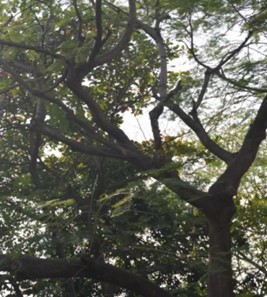
Fig.No.1: Delonix
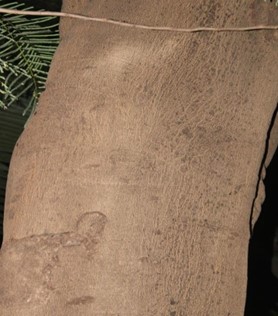
Fig.No.2: Trunk
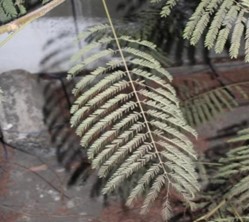
Fig No :3 leaf
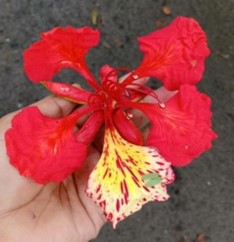
Fig No 4 :Flower
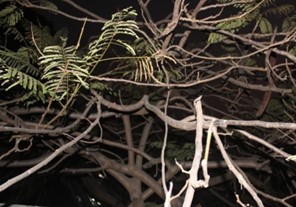
Fig.no.5: Branch & Stems
Table no.1: Taxanomic rank of Delonix regia.

Table no.2: Pharmacological activities of Delonix regia.

Benefits:
- Gulmohar has medicinal properties such as antibacterial, antifungal, anti-inflammatory, ‘ antibacterial, antibacterial, antioxidant, cardioprotective, gastroprotective and wound healing.
- The leaves have anti-diabetic properties and the use of the methanol extract significantly
- reduces blood blood sugar levels.
- 3 It's good for the environment.
- Used to control soil erosion.
- Disadvantages :
- Wood is susceptible to insects and animals and is somewhat difficult to maintain. is the tree of heat.
- Extreme winter he is not suitable for sowing Gulmohar
- Controlling crown spread is difficult.
Subspecies, varieties, forms and cultivars of Delonix genus:
D. baccal (Chiov.) Baker f. (Poinciana); D. boiviniana (Baill.) Capuron; D. brachycarpa (R.Vig.) Capuron ; D. decaryi (R.Vig.) Capuron (Flamboyant Tree); D. elata (L.) Gamble (Creamy Peacock Flower); D. floribunda (Baill.) Capuron (Poinciana); D. pumila (Poinciana); D. regia Bojer ex Hook.) Raf. – Royal Poinciana (Flame of the Forest); D. tomentosa (R.Vig.) Capuron;
D. velutina (R.Vig.) Capuron [5]. D. regia 'Kampong Yellow' (Flamboyant Tree); D. regia 'Smathers Gold' (Royal Poinciana); D. regia 'Supernova'; D. regia var. flavida; D. tomentosa (R.Vig.) Capuron ; D. velutina (R.Vig.) Capuron; D. a; D. alata; D. leucantha (Poinciana); D. leucantha bemarahensis; D. leucantha gracilis; D. leucantha, leucantha; D. leucantha subsp. bemarahensis; D. leucantha subsp. Gracilis [6].
Indian species of the genus Delonix
The genus Delonix in the phylum Eucaesalpinea consists of two species growing in India, Delonix elata and Delonix regia [7].
Delonix elata
Delonix elata (syn. Poinciana elata), commonly known as White Gold Mofur and Family Fabaceae [8]. Subfamily Caesalpiniaceae. In Gujarati, it is known as 'Sandesaro'. [9] Vernacula Name
Sanskrit- Siddeshwara [10]; Mumbai- Vayani; Telugu- Vatanaryana; Tamil- Vadanaryana [11]
Botanical Description: Erect tree 6-9 m tall. Stem: smooth and gray. leaves: compound, slender stalk, 10-20 cm long, bipinnate . [9, 12, 13]
Geographic distribution:
Delonix regia is native to Madagascar. It is now widespread in most subtropical and tropical regions of the world. It is native to Madagascar and Zambia. Brazil, Burkina Faso, Cyprus, Ethiopia, India, Jamaica, Nigeria, Puerto Rico, Singapore, South Africa, Uganda, United States, Egypt, Eritrea, Kenya, Mexico, Niger, Sri Lanka, Sudan, Tanzania.
Traditional Uses
leaves are used by traditional practitioners as a folk remedy for inflammatory joint diseases. [9, 14] Delonix elata is used in folklore for joint pain and flatulence. In Indochina, the bark is used as an antipyretic and anti-periodic agent. Locals make a paste of the leaves and bark and use it to relieve inflammation and pain. [8] Delonix elata has anti- inflammatory, anti-rheumatic [2, 15], antibacterial [15, 16] and antioxidant properties. [15?18] Reported Biological Activity Anti-inflammatory activity: The methanol extract of D. elata leaf extract and its ethyl acetate soluble and insoluble daughter fractions also showed significant anti-inflammatory activity compared to the control, but lower than that of the bark extract. [8,9] Antiulcer and Antinociceptive Activities: Ethanol extracts at doses of 100 and 200 mg/kg inhibited writhing with 55.56% and 54.76% inhibition, respectively, after treatment with and the gastric mucosal surface. Epithelial extracts that showed a significant reduction in were intact. [19]
In vitro antioxidant activity: The IC50 value for DPPH activity to scavenge free radicals was , 375 ± 176.77 mg/ml, and ascorbic acid was used as a standard. [20] anti-arthritic effects: treatment with ethanolic extracts of Delonix elata (250 and 500 mg.kg-1 body weight) significantly reduced hindlimb bone mass (HLBM). standard drug indomethacin (10 mg/kg) was used. As a result, Delonix elata ethanol extract was found to have potent anti-arthritic effects. [21]
Another species is Delonix regia Rafin. Delonix Legia Ruffin.
Delonix regia is a flowering plant species. In the traditional medical classification , it belongs to the Caesarpiniaceae family, but in the phylogenetic classification , it belongs to the Fabaceae (legume subfamily). This tree is native to Madagascar. It is a medium-sized ornamental tree, widely planted in streets and gardens in temperate and humid regions of India [22,23]. Also known as Royal Poinciana or Flamboyant. The plant was previously classified by him in the genus Poinciana after Phillippe de Longvilliers de Poincy (1583-1660), who is credited with introducing the plant to America [24,25].
Geographic distribution
Delonix regia Rafin.:
It comes from Madagascar, which is almost extinct. This plant is now widespread in most tropical and subtropical regions..
Exotic:
Brazil, Cyprus, Egypt, India, Kenya, Niger, Sri Lanka, South Africa, Uganda, United States, Jamaica.
Biophysical Limits:
Delonix regia seems to tolerate many types of soil from clay to sandy , but prefers sandy soils. The average annual temperature and precipitation for this plant should be 14- 260 °C and not less than 700 mm, respectively. The altitude range of this plant is 0-2000 m. Plant needs light. Grows weakly and sparsely in shade. Delonix Legia Ruffin. He is larger than in areas with high rainfall. It has a shallow root system and competes with neighboring shrubs and flowering plants by exposing the soil under the canopy. Therefore, this plant should be planted away from other plants in the garden. [26]
Taxonomical Classification :
Class:
Dicotyledons;
Subclass:
Rosidae;
Order:
Fabales;
Family: Leguminosae;
Subfamily: Caesalpinioideae;
Tribe:
Caesalpinieae;
Genus:
Delonix;
Specific epithet:
regia - (Hook.)
Botanical name:-
Delonix regia (Hook.)[6, 27]
Common Name:
English:
Flamboyant, Flamboyant Flame Tree, Flame of the Forest, Flame Tree, Gold Mohur, Gul Mohr, Peacock Flower, King Poinciana; Arabic: Goldmore; French: Luxury, Poinciana, Royal. Burmese: seinban; Spanish: Acacia roja; Swahili: mjohoro, mkakaya; Hindi: Gulmohr; Bengali: Chula, Lada. Tamil: Mayarum, Mayirkonrai, Panjadi, Telugu. [26] Form Delonix Legia Ruffin. It is 40 feet tall and has an umbrella-like canopy wider than .[11,28] Flowers: Large reddish orange with 5 petals and white stripes on 1 petal. petals somewhat larger than the others, of the same size and color, up to 8 cm long, with 4 spreading scarlet or orange- red petals , a fifth upright petal, called standard, slightly larger , with yellow and white spots. Sepals 5, thick, green outside, reddish inside with yellow rim, reflective when flower opens, sharp-tipped, finely hairy, about 2.5 cm long. 5 stamens, 10 red stamens. The pistil has a hairy unicellular ovary about 1.3 cm long. Style about 3 cm long. [5,26,29,30]
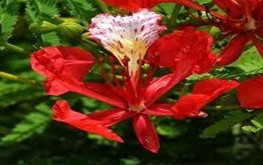
Fig 7: Gulmohar flower
Foliage:
Compound leaves are pinnate in appearance, characteristically bright, alternate, bright green. They are doubly pinnate. Each leaf is 30–50 cm long and has 20–40 pairs of primary leaflets, each of which is further divided into 10–20 pairs of secondary leaflets.
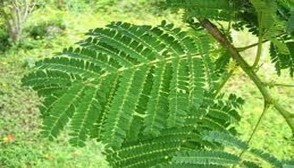
Fig 8: Leaves of Gulmohar tree
Branches:
Lateral branches with a diameter greater than the height of the tree, umbrella-shaped broad branches[26].
Root: Flat.[26]
Seeds:
Seeds 30-45, hard, greyish, shiny, 2 cm long, oblong, very similar in shape to date seeds, with bony seed coat. Mottled laterally . Weight about 0.4g. [31]

Fig 9: Gulmohar seed
Bark:
Smooth, grey-brown, slightly cracked, with many lenticels. Inner bark light brown .
Fruit (Pods):
Green and flexible when young, later dark brown, hard, woody pods, 30- 50 cm long, 3.8 cm thick, 5-7.6 cm wide. , ending with a short break. Inside are horizontally divided seed chambers that do not dehisce and eventually divide into two parts.[31]
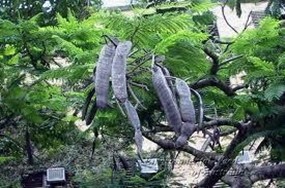
Fig 10: Gulmohar fruits
Reported Plant Components
Bark:
Flavonoids, Alkaloids, Saponins, Sterols, Stigmasterols, Carotenes, Hydrocarbons, Phytotoxins ?-Sitosterol, Lupeol 32, p-Methoxybenzaldehyde, Isorpeol, Carotenes, Hydrocarbons Phytotoxins and Phenols acid. [28,30,32,34,35]
Root bark:
glycosides, tannins, alkaloids, sterols, terpenoids, carbohydrates. [36]
Flowers:
flavonoids, tannins, alkaloids, saponins, steroids [28, 37] carotenoids (lycopene, phytoene, photofluene, beta-carotene, prolycopene, neolycopene, delta-lycopene, gamma- lycopene) , phenolic acids (gallic) acid). acid, protocatechuic acid, salicylic acid, trans-cinnamic acid .
Traditional Uses :
Delonix regia extract is known to have medicinal properties. [27, 40, 41]. This plant is used in several countries to produce extracts with antibacterial and antifungal activity. [42] Delonix Regia Ruffin. With an impressive array of medicinal and biological properties, has been used in several civilizations' folk remedies, including treating constipation, inflammation, arthritis, hemiplegia, leukorrhea, and rheumatism. [35, 43] Delonix Legia Raffin. Bloom is used in dysmenorrhea as an antibacterial, anti-inflammatory, broad-spectrum antibacterial, analgesic, antibacterial, and antifungal agent. [10, 44, 45, 46, 47] Flower is used as a traditional herbal remedy for gynecological conditions and as a tablet binder Many biological activity have been reported of Delonix regia Rafin.
Anti-diarrhoeal activity:
The flowers of the Delonix regia plant have been reported to possess in vivo antidiarrheal activity. Experimental models were castor oil-induced diarrhea, prostaglandin E2-induced enteropool, and charcoal-induced gastrointestinal motility test in Wistar albino rats. A 70% ethanolic extract of Delonix regia flowers was used for its activity.
Anti-inflammatory activity: Delonix regia leaf powder was used for the anti-inflammatory effects of Models for anti-inflammatory activity were carrageenan induced rat paw edema . Carrageenan-induced leg edema. Ethanol extract (400 mg/kg) significantly inhibited carrageenan-induced paw edema. Ethanol extract produced a dose-dependent suppression of carrageenan edema comparable to known anti-inflammatory drugs. Ethanol extract of Delonix regia produced significant (P < 0>
IMPORTANCE :
The tree is valued primarily for its seeds, foliage, shade, and ornamental use. The seeds yield 18-27.5% fixed oil known as 'pangam' or 'kalanga' oil of trades and its main use is the tanning industry. The oil and its "kalyan" have insecticidal and antibacterial properties. The wood is used locally for agricultural tools. Handles for carpentry tools, combs, etc. Its main use is fuel, and the calorific value of wood is 4600 kcal/kg. Glibenclamide (10,444 mg/kg) was used as a standard reference drug. At each glucose dose, statistical data showed a significant oral hypoglycemic effect in mice. Maximum antihyperglycemic activity was measured at 400 mg/kg of the drug extract. [52]
Antioxidant activity:
Various extracts from leaves, flowers and bark of Delonix Regia Raffin. such as absolute methanol, absolute ethanol, absolute acetone, 80% methanol, 80% ethanol, 80?etone, deionized water were used for antioxidant activity. Extraction yields of leaves, flowers and bark ranged from 10.19 to 36.24, 12.97 to 48.47 and 4.22 to 8.48 g/100 g dry weight (DW), respectively. Among all the extracts, the 80% methanolic extract producing from leaves had high phenol content (3.63 g GAE/100 g DW), total flavonoid content (1st.19g CE/100g DW), , showed significantly (P < 0>
Hepatoprotective activity:
This study was designed to evaluate the beneficial effects of methanol extract from the aerial parts of Delonix regia in rats with CCl4-induced liver injury. A methanol extract from the aerial parts of D. regia has hepatoprotective activity against CCl4 induced hypersensitivity in rats.[51]
Antimicrobial activity:
Dichloromethane extract of Delonix regia Rafin. Bratt led the separation of scopoletin by silica gel chromatography. Scopoletin exhibits antifungal activity against Candida albicans and antibacterial activity against Pseudomonas aeruginosa, Escherichia coli , Staphylococcus aureus and Bacillus subtilis. Plant extracts were inactive against the fungi, Apergillus niger and Trichophyton mentagrophytes. The antibacterial activity of different extracts (15 ?g mm-2) was measured by disc diffusion method. The inhibition zones detected by petroleum ether, carbon tetrachloride, and dichloromethane fractions ranged from 9 to 14 mm, 11 to 13 mm, and 9 to 20 mm, respectively. Kanamycin with a zone of inhibition of 20-25 mm was used as standard drug. In the Artemia lethality bioassay , carbon tetrachloride solubles showed the highest toxicity with a LC50 of 0.83 mg ml-1, while the petroleum ether and dichloromethane soluble components of the methanol extract had LC50s of 14.94 and 3, respectively. 29. mg ml-1. Vincristine sulfate with an LC50 of 0.812 mg mL-1 was used as reference drug . [30, 55]
Anthelmintic effect:
Anthelmintic effect of Delonix regia Rafin. Flower, plant , belonging to the family Caesalpiniaceae, has been reported against Pheritima posthuma Aqueous and methanolic extracts of Delonix regia Rafin. Bloom was ingested at three earthWorm concentrations (25, 50, and 100 mg/ml). Determination of the timing of paralysis and the timing of death in worms was reported. Piperazine citrate (10 mg/ml) was used as standard drug and distilled water was used as a control. Both the aqueous and methanolic extracts exhibit considerable anthelmintic activity, with the methanolic extract exhibiting the Highest activity.[56]
Wound Healing Activity:
A wound healing study was conducted to investigate the wound healing properties of Delonix regia in experimental animal models. His ethanolic and aqueous extracts of Delonix regia flowers were prepared to examine their effects on wound healing. His animals used were albino rats. Wound models were incisional and excisional wounds. Wound healing was assessed by estimation of wound contraction rate, duration of epithelialization, tensile strength (skin breaking strength), and skin hydroxyproline content. Ethanolic and aqueous extracts of greatly accelerated the healing process. [50] Gastroprotective effects: ethanol extract of flowers of Delonix regia Rafin. was obtained and tested for gastroprotective activity in the experimentally induced ulcer model. Various parameters such as ulcer index, gastric pH, protection rate in all models, and gastric volume, free and total acid in pylorus ligation-induced models with gastric ulcer were monitored. Gastroprotective activity of ethanolic extract from his flowers of Delonix regia Rafin.
CONCLUSIONS:
The plant Delonix regia (Gulmohar) has been reported to contain polyphenolic compounds, namely flavonols, anthocyanins, and phenolic acids, as bioactive secondary metabolites responsible for various medicinal effects. Its leaves, flowers, and seeds have antidiarrheal, anthelmintic, antidiuretic, larvicidal, antihemolytic, wound-healing, antiarthritic, gastroprotective, antiemetic, and antibacterial effects. shows various pharmacological actions. activity, hemoglutination activity, hepatoprotective activity, hypoglycemic activity, anti-inflammatory activity, analgesic activity, antioxidant activity, antimalarial activity, and free radical scavenging effect.
REFERENCE
- Gledhill and David. The Names of Plants (4 ed.). Cambridge University Press. 2008; p.137. ISBN978-0-521-86645-3.
- Kirtikar K.R. and Basu Major B. D. Indian medicinal plants; 2nd edition, International book distributors.1999;volII:852.
- Thirugnanam S, Mooligai M. (Tamil) Trichy: Selvi Publishers. 2003; p.33, 117, 131, 139, 147.
- Rani P. Maria jancy, Kannan P. S. M. and Kumaravel S. Screening of antioxidant activity, total phenolics and gas chromatograph and mass spectrometer (GC-MS) study of Delonix regia; African Journal of Biochemistry Research. 2011; 5(12): 341-347.
- On line, (2012). http://en.wikipedia.org/wiki/Delonix_regia. Reterived on July 28, 2012.
- Anonymous,http://zipcodezoo.com/Key/Plantae/DelonixGenus.asp.Zipcodezoo. com. Reterived July28,2012.
- Gamble, J.S.. Flora of the Presidency Of Madras. Bishen Singh Mahendra Pal Singh, Dehradun.India.1986;Vol.1,P.396.
- Rao R.V. Krishna, Rao Ganapathy P. Mallikarjuna and Rao B.Ganga . Anti-inflammatory activity of the leaves and bark of Delonix elata. Ancient Science of Life. 1997; 17 (2): 141. – 143.
- Wijayasiriwardena C., Sharma P. P., Chauhan M. G., Pillai A.P.G.. Delonix elata (L.) Gamble from folklore practice; AYU. 2009; 30(1): 68-72.
- Sharma, P.V.. Shodhala Nighantu, Oriential Institute, Baroda, Gujarat. 1978; pp. 77.
- Chopra R. N., Nayar S. L. and Chopra I. C.. Glossary of Indian Medicinal Plants CSIR, New Delhi.1956;p.92.
- Cooke, T. C.I.E.. Flora of the presidency of Bombay, Taylor & Francis, London. 1903; Vol. I:282-283.
- Shah, G.L.. Flora of Gujarat, Part I, University, Sardar Patel University, Vallabh Vidyanagar. 1978;1stEdn.pp.169&274.
- Samvatsar S. and Diwanji V. B.. Plants used by the tribals of western M.P.; J.Econ.Taxon.Bot.1999;23(2),305-314.
- Muruganathan G., Mohan S. Anti-inflammatory and antiarthritic activities of Delonix elata bark extracts. International journal of research in ayurveda and pharmacy. 2011; 2(6): 1819 1821.
- Sivanarayana V., Suryavathana. Preliminary studies, phytochemical and antimicrobial activity on Delonix elata and Prosopis cineraria. International journal of current research. 2010; 8:66-69.
- Pavithra P, Janani V, Charumathi V, Indumathy R, Sirisa P, Rama S . Antibacterial activity of plants used in Indian herbal medicine. International journal of green pharmacy. 2010; 1: 22- 28.
- Sini KR, Sinha BN, Karpagawalli M. Determining the antioxidant activity of certain medicinal plants attapady (Palakkad), India Using DPPH assay. Current botany. 2010;1(1): 13- 7.
- Manimekalai K., Salwe Kartik J. and Shetty Harsha M.. Evaluation of protective effect of Delonix elata on chronic inflammation and comparison of its ulcerogenic potential with Ibuprofen. International Journal of Pharma and Bio Sciences. 2011; 2(2): 237-243.
- Doss A., Doss A. Pichai Anthony and Dhanbalan. In vitro antioxidant properties of certain indigenous medicinal plants from Western ghats of India. The internet journal of nutrition and wellness2009;7(1).
- Madhu A, Shivalinge Gowda KP and Manjula B. Novel therapies to combat HIV: a review. Research Journal of Pharmacology and Pharmacodynamics. 2009;1(1): 25.
- Anonymous. Wealth of India, A Dictionary of Indian Raw Material and Industrial Product, CSIR, New Delhi, India. 1952; vol. 3, 30,
- Anonymous,(2012).http://www.worldagroforestrycentre.org/sea/products/afdbases/af/ asp/SpeciesInfo.asp?SpID=648. World agroforestry centre. Reterived on July 27, 2012.
- Meenakshisundaram M., Santhaguru K. and Rajenderan K.. Effects of bioinoculants on quality seedlings production of Delonix regia in tropical nursery conditions. Asian Journal of Biochemical and Pharmaceutical Research Issue. 2011; 1(1): 98-107.
- Abdullahi S.A. and Abdullahi G.M. (2005). Effect of boiling on the proximate, antinutrients and amino acid composition of raw Delonix regia seeds. Nigerian food journal. 2005:23.
- Pacheco-Aguirre J., Rosado-Rubio G., Betancur-Ancona D. and Chel-Guerrero L.. Physicochemical properties of carboxymethylated flamboyant (Delonix regia) seed gum. CyTA - Journal of Food. 2010; 8(3): 169–176.
- Hamdoon Mohammed (2009). Natural and synthetic flavonoid derivatives with potential antioxidant and anticancer activities. University of Saarland, Saarbrücken, Germany, retervied on January1,2012.
- Shanmukha I, Harshil Patel, Jignesh Patel and Riyazunnisa. Quantification of total phenol and flavonoid content of Delonix regia flowers; International Journal of Chem Tech Research. 2011;3(1):280-283.
- Ponnusami V., Aravindhan R., Karthik N. Raj, Ramadoss G., Srivastava S.N.. Adsorption of methylene blue onto gulmohar plant leaf powder: Equilibrium, kinetic, and thermodynamic analysis. Journal of environmental protection science. 2009; 3: 1–10.
- Jahan Israt, Rahman Mohamaad S., Rahman Mohammad Z., Kaisar Mohammad A., Islam Mohamaad S., Wahab Abdul and Rashid Mohammad A.. Chemical and biological investigation of Delonix regia (Bojer ex. Hook) Raf. Acta Pharmaceutica. 2010; 60(2): 207-215.
- Arora Arun, Sen Rajendra and Singh Jitendra. Fatty acid composition of Delonix regia (Gulmohar) seed oil from arid zone of Rajasthan. J. Ind. Council chem. 2010; 27(2): 150- 152.
- Lakshmi Vijai. Constituents of wood of Delonix regia. National academy Science Letters. 1987;10(6):197-198.
- Jungalwala F.B. and Cama H.R.. Carotenoids in Delonix regia (Gul Mohr) Flower. Biochem. Journal.1962;85(1):1-8.
- Sammour R. H., El-Shanshoury A. E. R.. Antimicrobial activity of legume seed proteins. Bot.Bull.Acad.Sin.1992;33:185-190.
- 35. Shabir Ghulam, Anwa Farooq, Sultana Bushra, Khalid Zafar M., Afzal Muhammad, Khan Qaiser M. and M. Ashrafuzzaman. Antioxidant and antimicrobial attributes and phenolics of different solvent extracts from leaves, flowers and bark of Gold mohar [Delonix regia (Bojer ex Hook.)2011;16:7302-7319.
- Sama Kavitha and Xavier Vergeese Raja A. Preliminary phytochemical screening of root bark of Delonix regia. International research journal of pharmacy. 2011; 2(10): 42-43.
- Parekh J, Chanda SV. In vitro activity and phytochemical analysis of some Indian medicinal plants. Turk J Biol. 2007; 31: 53-58.
- Adje Felix, Lozano Yves F., Meudec Emmanuelle, Lozano Paul, Adima Augustin, Agbo N’zi Georges and Gaydou Emile M.. Anthocyanin Characterization of Pilot Plant Water Extracts of Delonix regia Flowers. Molecules. 2008; 13: 1238-1245.
- Jungalwala FB, Cama H.R.. Carotenoids in Delonix regia flower. Biochem J. 1962; 85, 1.
- Joy P.P., Mathew J.S., Skaria B.P.. Medicinal plants. Trop. Horticult. 2001; 2, 449-632.
- Jyothi M.V., Mandayan S.N., Kotamballi N.C., Bhagyalakshmi N.. Antioxidative efficacies of floral petal extracts of Delonix regia Rafin.; Int. J. Biomed. Pharmaceut. Sci. 2007; 1: 73-82.
- Sammour R. H., El-Shanshoury A. E. R.. Botanical Bulletin of Academia Sinica (Taipei). 1992,33:185.
- Lawal, O., Uzokwe, N.E., Igboanugo, A.B.I., Adio, A.F., Awosan, E.A., Nwogwugwu, J.O., Faloye, B., Olatunji, B.P., Adesoga, A.A.. Ethno medicinal information on collection and identification of some medicinal plants in Research Institutes of South- west Nigeria. Afr. J. Pharm. Pharmacol. 2010; 4, 1-7.
- Raghunathan K, Miss Roma Mitra. Pharmacognosy of indigenous drugs. Central council for research in ayurveda and sidda, New Delhi. 1982; 2: 654-666.
- Asima Chaterjee and Satyesh Chandra Prakashi. The treatise on Indian medicinal plants New Delhi. Publications and information Directorate. 1992; 2:125- 126.
- Jamal Ahemad, Adbel- Barry, Mohammed HH, Al-Hakiem. Acute intraperitoneal and oral toxicity of the glycosidic extract of Trigonella foenumgraecum in mice. J Ethanopharmacol. 2000; 70: 65-68.
- Shiramane Rajabhau S, Biradar Karnakumar V, Chivde Basavaraj V, Shambhulingayya HM and Goud Veerana . In-vivo anti-diarrhoeal activity of ethanolic extract of Delonix regia flowers in experimental induced diarrhoea in Wistar albino rats. International journal of research in pharmacy and chemistry. 2011; 1(3): 442-447.
- Vidyasagar GM, Prashantkumar P. Traditional herbal remedies for gynecological disorders in women of Bidar district, Karnataka, India. Fitoterapia. 2007; 78: 48.
- Kale RH, Joshi UM, Ambhore DP, Sitaphale GR. Evaluation of Delonix regia Raf. Endospermic mucilage as tablet binder. Int J ChemTech Res. 2009; 1(1): 11.
- Khan Mohd Asif, Amit Saxena, Farheen Tabassum Fatima, Gaurav Sharma, Veerana Goud and Asif Husain. Study of wound healing activity of Delonix regia flowers in experimental animal models. American Journal of Pharmtech Research. 2012; 2(2): 380-390.
- Shewale Vaishali D., Deshmukh Tushar A., Patil, Liladhar S. and Patil Vijay R.. Anti- Inflammatory Activity of Delonix regia (Boj. Ex. Hook). Advances in Pharmacological Sciences. 2011;2012:1-4.
- Rahman M, Hasan N, Das AK, Hossain T, Jahan R, Khatun A, Rahmatullah M. Effect of Delonix regia leaf extract on glucose tolerance in glucose induced hyperglycemic mice. Afr J Tradit Complement Altern Med. 2011;8(1):34-6.
- Rani P. Maria jancy, Kannan P. S. M. and Kumaravel S.. Screening of antioxidant activity, total phenolics and gas chromatograph and mass spectrometer (GC-MS) study of Delonix regia. African Journal of Biochemistry Research. 2011;5(12): 341-347.
- Ahmed Jameel, Nirmal Sunil, Dhasade Vipul, Patil Anuja, Kadam Sagar, Pal Subodh, Mandal Subhash and Pattan Shashikant. Hepatoprotective activity of methanol extract of aerial parts of Delonix regia; Phytopharmacology. 2011;1(5): 118-122.
- Ragasa C.Y., Hofilena J.G. Antimicrobial coumarin derivative from Delonix regia. 2011;7(1):7-11.
- Ahhirao R.A., Patel M.R., Hamid Sayyed and Patil J.K.. In vitro anthelmintic property of gulmohar flowers against Pheritima posthuma; Pharmacolgyonline. 2011;1:728-732.
- Shiramane Rajabhau S, Chivde Basavaraj V, Kamshetty Manoj V., Biradar Karnakumar V and Khan Asif.. Gastroprotective activity of ethanolic extract of Delonix regia flowers in experimental induced ulcer in Wistar albino rats; International research journal of pharmacy. 2011;2(5):234-238


 Mayur B. Mane*
Mayur B. Mane*











 10.5281/zenodo.11451428
10.5281/zenodo.11451428